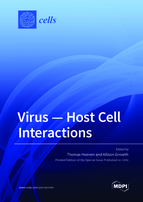Virus — Host Cell Interactions
A special issue of Cells (ISSN 2073-4409). This special issue belongs to the section "Cellular Immunology".
Deadline for manuscript submissions: closed (31 March 2021) | Viewed by 46823
Special Issue Editors
Interests: virology; molecular biology; filoviruses; virus - host interactions
Special Issue Information
Dear Colleagues,
As obligate intracellular parasites, viruses are intimately interconnected with their host cells. Virus–host cell interactions, on the one hand, allow viruses to reprogram cells for their own purposes, but also provide a means for the host cell to combat virus infection. This close connection between host and viral processes means that the fields of cell biology and virology have often inspired each other.
In particular, many discoveries in cell biology have been made possible by the study of viruses, while, at the same time, our fundamental understanding of the virus life cycle is inherently rooted in the principles of cell biology. Further, by examining cellular responses to infection, insight can be obtained regarding the mechanisms associated with the restriction of virus infection or, in cases where control is ineffective, pathogenesis. Such knowledge is a prerequisite for the successful modulation of such responses to develop host-directed therapies for the control of viral infections. Further, from a practical point of view, virus–host cell interactions also provide important targets for the development of indirectly acting antivirals, which due to their reliance on host cell components have a reduced likelihood for the development of resistance.
In this Special Issue of Cells, we invite both review papers discussing the current state of our knowledge regarding virus–host cell interactions and research articles reporting new and relevant discoveries in this area of research, including reports describing novel technologies relevant to the study of virus–host cell interactions. We hope that this Special Issue will bring together researchers from a diverse range of virus families with a common interest in the virus–host interface and thus precipitate fruitful discussions regarding common themes and the emergence of shared host cell factors and pathways important for diverse viral infections.
Dr. Thomas Hoenen
Dr. Allison Groseth
Guest Editors
Manuscript Submission Information
Manuscripts should be submitted online at www.mdpi.com by registering and logging in to this website. Once you are registered, click here to go to the submission form. Manuscripts can be submitted until the deadline. All submissions that pass pre-check are peer-reviewed. Accepted papers will be published continuously in the journal (as soon as accepted) and will be listed together on the special issue website. Research articles, review articles as well as short communications are invited. For planned papers, a title and short abstract (about 100 words) can be sent to the Editorial Office for announcement on this website.
Submitted manuscripts should not have been published previously, nor be under consideration for publication elsewhere (except conference proceedings papers). All manuscripts are thoroughly refereed through a single-blind peer-review process. A guide for authors and other relevant information for submission of manuscripts is available on the Instructions for Authors page. Cells is an international peer-reviewed open access semimonthly journal published by MDPI.
Please visit the Instructions for Authors page before submitting a manuscript. The Article Processing Charge (APC) for publication in this open access journal is 2700 CHF (Swiss Francs). Submitted papers should be well formatted and use good English. Authors may use MDPI's English editing service prior to publication or during author revisions.







